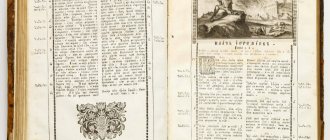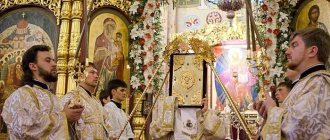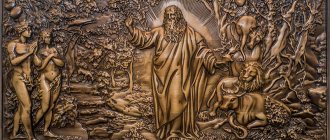Was there anything before the Synodal translation? History of Bible translation into Russian
As of 2021, individual books of Scripture have been translated into 3223 languages, but the entire Bible (Old and New Testaments) has been translated into only 636 languages, including Russian.
According to the United Bible Societies, today 95% of the world's population has the opportunity to read the Bible in their native language.
We have prepared a column about the history of translations into Old Slavic and Russian.
BIBLE OF CYRILL AND METHODIA (885)
“Our people are baptized, but we still don’t have teachers. We do not understand either Greek or Latin... We have no written language, and we do not understand the meaning of what is written; therefore, send us teachers who could teach us to read and understand the Scriptures” (Rostislav, Moravian prince, 862).
In 863 AD, Rostislav, prince of Great Moravia, sent a petition to Byzantium asking the emperor to send him teachers of the Christian faith. In response to the request, the emperor sent two brothers to the prince - Cyril and Methodius.
Their goal was to establish an independent church with its own liturgy. To conduct worship in the Slavic language, Cyril and Methodius first of all needed to create the Slavic alphabet. Only after this could they translate church books into Slavic. The brothers began by translating the Psalter and then took up the New Testament. After the death of Cyril, Methodius and his disciples continued this work, and also completely completed the translation of the Old Testament.
Translations of Cyril and Methodius became widespread among the Slavic peoples, including in Rus'. So, churches had already appeared there, and people could read the Bible, translated by the enlightenment brothers even before the Baptism of Rus, which took place in Kyiv in 988 and marked the beginning of the Christianization of Kievan Rus (Ancient Rus).
Today it is difficult to objectively assess the quality of the translation made by Cyril and Methodius. Only a few handwritten copies have survived to this day, approximately dating from the time when the brothers made the translation. These rare ancient manuscripts allow linguists to note that this translation is accurate and sounds pleasant and natural. The work “Our Slavic Bible” notes that the brothers “had to create many new words and expressions... And they did this with amazing accuracy [and] incredibly enriched the Slavic language with vocabulary” (“Our Slavic Bible”).
GENNADIAN BIBLE (1499)
In the 15th century, Rus' did not yet know the complete and complete Bible, although some of its books were used. The need for a complete collection of biblical books arose as a result of a dispute between Abbot Zachary, abbot of one of the monasteries, and Archbishop Gennady. Zachary criticized the church hierarchy and insisted on a biblical understanding of the pastorate, but in his arguments he referred to biblical scriptures unknown to Gennady.
Gennady Bible (beginning of Genesis)
In the 15th century, Archbishop Gennady set the task of collecting the books of Holy Scripture into a single Bible in the Slavic language. He organized a search for parts of the Slavic Bible in monasteries and cathedrals. Some of the books could not be found, and they were translated from the Latin Vulgate by the monk Benjamin. A copy of the Gennadian Bible has survived to this day. The Bible now used by the Orthodox Church in worship in Russia and other Slavic countries differs from Gennady’s text only in minor (but numerous) corrections.
The book is the highest example of book art of its time. Three persons wrote the Gennadian Bible: their names are preserved in the book itself.
These were ministers of the Novgorod churches: clerks Vasily Jerusalemsky, Gridya Ispovednitsky and Kliment Arkhangelsky. The Gennadian Bible has 1002 leaves, its size is 33x23.5 cm, written on high-quality paper by calligraphic scribes. The binding of the Gennadian Bible dates back to the end of the 15th - beginning of the 16th century.
But not only antiquity (and the book is already more than 500 years old), not only the height of book art attracts the attention of scientists - biblical scholars, historians, philologists, bibliologists. In the history of Russian book culture, the Gennady Bible stands on a par with such epoch-making handwritten books and printed publications as the Ostromir Gospel (1056–1057), the Kiev Psalter (1397), the first printed Apostle of Ivan Fedorov (1564), the first printed Ostrog Bible (1580–1581) ), the Elizabethan Bible (1751) and the first synodal edition of the Bible in Russian (1876). Each of these books represents an important milestone or a new stage in the development of Russian culture. But the Gennadian Bible of 1499 stands out both among the above-mentioned manuscripts and among the first printed editions of the Bible.
The appearance of the Gennadian Bible testified that by the end of the 15th century, Russian culture and the national self-awareness of Russians had reached such a high level that the experience of collecting all the holy books of the Old and New Testaments into one codex became possible and feasible.
OSTROG BIBLE (1581)
The first completed edition of the Bible in Church Slavonic, published in Ostroh by the Russian pioneer Ivan Fedorov in 1581 with the help of the Orthodox Prince Konstantin Ostrozhsky, with the blessing of the Dubno abbot Job.
Title page of the Ostrog Bible
The Ostrog Bible consists of 76 books of the Old and New Testaments (compared to current editions of the Church Slavonic Bible, only the Epistle of Jeremiah is missing). Some parts of it were based on translations by Francis Skaryna. Among the sources they also indicate the “Gennady Bible” - a manuscript from the end of the 15th century. The preface was written by G. D. Smotritsky, the father of Meletius Smotritsky.
There are copies with various imprints located at the end of the book. A small part of the copies has on the last sheet the text of the imprint (colophon) in the form of a triangle with the date July 12, 1580; below is the typographic mark of Ivan Fedorov. In other copies, the text ends in two columns; the ending is placed below the typographical mark and imprint (in Greek and c.) with the date August 12, 1581. In this regard, there is often talk of two different editions of the book. However, the title page of all known copies bears the year 1581; according to the observations of A. S. Zernova, who described 29 copies, there was only one edition, although for some reason it was delayed and some sheets were reprinted (in particular, errors were corrected); There are quite a lot of different combinations of reprinted and non-reprinted sheets.
Like all publications by Ivan Fedorov, the Ostroh Bible was typed and laid out impeccably. It uses a small but readable Ostrog font for the main text, semi-standard with elements of cursive style, and typesetting in two columns. The volume of the text is estimated at 3,240,000 printed characters. The Ostrog Bible was reprinted practically unchanged in Moscow in 1663, so that in fact it was the official edition of the Slavic Bible until the 1740s, when the corrected so-called Elizabethan Bible was prepared, which is still in use today.
The circulation was huge at that time: according to some estimates, from 1000 to 1500 copies. Leaving Ostrog, Ivan Fedorov took 400 of them with him. An inventory of his property, compiled two years after his death, mentions 120 complete Bibles in sheets (that is, unbound) and 80 incomplete ones. The missing sheets were reprinted later in Vilna in a noticeably different font.
About 450 individual copies of the Ostroh Bible are described in the literature. To date, about 350 copies have survived (in whole or in part).
The Ostroh Bible is widely known in Ukraine, Russia and Belarus, as well as in other countries. It is contained in the Oxford Library. Also, its copies were owned by the Swedish king Gustav Adolf, Cardinal Barberini, and many scientists and public figures of the era of Ivan Fedorov.
The significance of the Ostrog Bible was great for Orthodox education, which was forced to withstand strong Catholic pressure in Ukraine and Belarus.
MOSCOW BIBLE (1663)
The Moscow Bible was published according to the decision of the council of 1660 and was mainly reprinted from the Ostrog Bible. In the Ostrog text, few and not the most important translation errors were corrected. It is unknown who made these corrections. Many errors that could have been noticed when comparing the Greek text of the LXX and the New Testament original were not corrected. There were also numerous typographical errors in the publication. Patriarch Nikon, who advocated for more significant corrections, was dissatisfied with this publication. Further systematic work on the translation led to the Elisabeth edition of 1751.
Bibles from 1663 are a remarkable example of Moscow printing in the 17th century. The book has a title page with a decorative-architectural frame with images of saints and prophets. The frontispiece depicts the God of Hosts in the clouds and scenes from the Old and New Testaments. They frame the Russian coat of arms - a double-headed eagle, on the chest of which Tsar Alexei Mikhailovich is depicted instead of St. George the Victorious. Below the coat of arms is a woodcut printed with a plan of the city of Moscow with the Kremlin in the center. Probably the author of these woodcuts was the bannerman Zosima, mentioned in the reports of the Moscow Printing House.
ELIZABETHIN BIBLE (1751)
On November 14, 1712, Peter the Great issued a decree on checking and correcting the Slavic Bible. With this decree, the king ordered that the highest ranks be informed about the discrepancies between the Greek and Slavic Bibles. However, the clergy, remembering that a previous attempt to edit the Bible ended in a schism of the Church in 1666, did not want to take on such a large responsibility. They worked on revising the Bible for 10 years, but this activity was stopped after the death of the emperor. And only during the reign of Elizabeth Petrovna the corrected Bible was published.
On December 18, 1751, the Elizabethan Bible went out of print. All changes made when correcting the translation were agreed upon, and the notes to the text formed a separate volume, almost equal in volume to the text of the Bible itself. The first edition quickly sold out and in 1756 its second edition was published with additional notes in the margins and engravings, in which Hieromonk Gideon (Slonimsky) corrected the errors and typos of the first edition. The Elizabethan Bible, with minor graphical edits, is still used as the authorized text for worship in Russian Orthodoxy.
NEW TESTAMENT OF THE RUSSIAN BIBLE SOCIETY (1821)
The Russian Bible Society was founded in 1814 by decree of Emperor Alexander I, who himself was an active member. At first, the society was engaged in distributing the Slavic Bible, and in 1816 it published the Slavic Bible in its own edition and as a separate book - the New Testament.
At this time, it was decided to begin translating the Bible from Greek into Russian. The New Testament in Russian, a modern language for that era, was published in 1821, after which work began on translating the Old Testament. In 1823, the Psalter was published in Russian, and by 1825 the Pentateuch of Moses and the Book of Ruth were translated. In the same year, Alexander I died, and work on the translation was suspended until 1856.
SENODAL TRANSLATION (1876)
In 1703, Tsar Peter I decided to publish the New Testament in Russian. He entrusts its translation to the German pastor Gluck, known for his philological works. Working in Moscow, Pastor Gluck completes the translation. But in 1705, Pastor Gluck died, and after his death the translation he left behind disappeared.
In 1813, the Russian Biblical Society was founded in Russia, with the goal of printing and distributing the books of the Holy Scriptures among the peoples of the country. It was decided to sell them at a low price and distribute them free of charge to the poor. In 1815, after returning from abroad, Emperor Alexander I ordered “to provide Russians with a way to read the Word of God in their natural Russian language.” The question of the Russian translation of the Bible was raised again.
The Russian Bible Society took responsibility for publishing the books of Holy Scripture in Russian, and the translation was entrusted to members of the St. Petersburg Theological Academy.
In 1818, the first edition of the four Gospels in parallel in Russian and Church Slavonic came out of print, and in 1822 the Russian New Testament was printed in its entirety for the first time. Then they began to translate and print the books of the Old Testament. At the same time, translations of the Holy Scriptures were made into the languages of other peoples of the Russian Empire.
Some representatives of the highest church authorities had a negative attitude towards the activities of the Bible Society. They believed that the Bible should be in the hands of the clergy and that the people should not be allowed to read and study it on their own. In 1824, Metropolitan Seraphim asked the Tsar to ban the Bible Society. In April 1826, by decree of Emperor Nicholas I, the activities of the society were terminated. By this time, the printing house of the Russian Bible Society had managed to print about a million copies of the books of the Holy Scriptures in 26 languages of the peoples of Russia.
After the Society's activities were banned, work on the Russian translation of the Bible was suspended. Soon the sale of the Russian New Testament was stopped.
However, the first Metropolitan of Moscow, Saint Philaret (Drozdov), in 1858 nevertheless obtained permission from the Tsar to translate and print the Holy Scriptures in Russian. The translation was carried out under the leadership of the Synod (the highest administration of the Russian Orthodox Church).
A lot of work has been done to ensure that the Russian translation of the books of the Holy Scriptures corresponds as closely as possible to the texts of the ancient originals, and also has literary merits.
In 1862, forty years after the first edition of the Russian New Testament, its second edition, somewhat improved, was published in more modern Russian.
It was decided to re-carefully prepare a translation of all the books of the Old Testament. For this purpose, in 1860, a special committee was elected at the St. Petersburg Theological Academy. The translation of the Old Testament was done by professors of the St. Petersburg Theological Academy: M. A. Golubev, E. I. Lovyatin, P. I. Savvaitov - a famous archaeologist and historian, D. A. Khvolson - a Christian of Jewish origin, professor of the St. Petersburg Theological Academy. Professor of the Kyiv Theological Academy M. S. Gulyaev also worked a lot on the translation.
The Old Testament was translated from the Hebrew (Masoretic) text of the Bible, and the New Testament from Greek. The translators were also guided by the Greek text of the Septuagint, used the Latin translation of Jerome and the previously made Russian translation.
In 1876, the complete Russian Bible came out of print for the first time. Its text is sometimes called “synodal”, since it was published under the leadership of the Synod. This happened almost three centuries after the appearance of the original Church Slavonic Bible.
Today this is one of the most popular translations, which nevertheless has a number of disadvantages:
- the language and style of the Synodal translation are far from the language and style of Russian literature - both modern and classical;
- often the same proper name in different books (and sometimes within the same book) is rendered differently in the Synodal translation, and sometimes, on the contrary, various Jewish names and geographical names coincide in Russian transcription. Often proper names are translated as if they were common nouns or even verbs, and in some cases common nouns are transcribed as proper names. There is an inaccuracy in the transfer of realities, everyday and social features of the ancient world, unknown or misunderstood by the science of the 19th century.
On the cover - Cyril and Methodius, ser. 11th century
INVICTORY is now on Youtube, Instagram and Telegram!
Want the best content delivered straight to your favorite platforms? We prepare for you reviews of new films, interesting podcasts, breaking news and useful tips from ministers on popular platforms. Many materials are published only on them, without even getting to the site! Subscribe and be the first to receive the most interesting information!
Story
Ancient translations
Aramaic Targums
Greek Septuagint
The translation now known as the Septuagint was widely used by Greek-speaking Jews and later by Christians. It differs somewhat from the later standardized Hebrew (Masoretic text). This translation was aided by a legend (mostly recorded as the Letter of Aristaeus) that seventy (or, in some sources, seventy-two) separate translators produced identical texts; supposedly proving its accuracy.
Zaokskaya Bible (2015)
A joint publication of the Institute of Bible Translation at the Zaoksk Theological Academy and the Biblical-Theological Institute of St. Apostle Andrew.
A new modern translation of the books of the Holy Scriptures of the Old and New Testaments was carried out by leading Russian scientists - biblical scholars and philologists of various Christian denominations, based on the latest scientific editions of ancient texts and the latest achievements of modern biblical studies, among whom Mikhail Petrovich Kulakova (director and editor-in-chief of the Institute of Bible Translation, Doctor theology - Adventist University of Texas; Doctor of Divinity - Andrews University) and his son Mikhail Kulakova (Master of Divinity, Andrews University, Doctor of Divinity, Oxford University), who continued his work after his father.
The main work on it was carried out in the village of Zaoksky, Tula region, where the Institute of Bible Translation at the Adventist Academy is located.
The main idea of this translation is not at all the degree of literalness. It rather belongs to the field of stylistics: the translation moves away from the clerical or ponderous figures of speech of the Synodal tradition, but at the same time carefully avoids vernacular and vulgarity and preserves from traditional terminology and phraseology everything that can be preserved without compromising understanding. He is emphatically old-fashioned, but this old-fashionedness is alien to inarticulateness.
This is a rather conservative translation, as can be understood from the archaisms: “so that”, “so”, etc. In themselves, the archaic and solemn style of the style is not at all a drawback of the translation; they become one when they begin to interfere with an adequate understanding of the text, and the given translation is generally free from such errors.
Modern translation efforts
Bible translation statistics (for selected years)
| Year | Complete Bible | New Testament | Portions | General |
| 1996 | 308 | 764 | 1014 | 2086 |
| 2006 | 426 | 1114 | 862 | 2402 |
| 2010 | 457 | 1211 | 897 | 2565 |
| 2011 | 513 | 1276 | 1015 | 2804 |
| 2012 | 518 | 1275 | 1005 | 2798 |
| 2013 | 513 | 1309 | 1028 | 2850 |
| 2014 | 531 | 1329 | 1023 | 2883 |
| 2015 | 554 | 1333 | 1045 | 2932 |
| 2016 | 636 | 1442 | 1145 | 3223 |
| 2017 | 670 | 1521 | 1121 | 3312 |
| 2018 | 683 | 1534 | 1133 | 3350 |
| 2019 | 698 | 1548 | 1138 | 3384 |
They estimate that as of October 2021, approximately 171 million people spoke these 2,115 languages, for which translation work still needs to begin. There are a total of 3,969 languages that have no Bible translation at all, but many of them will probably never need a Bible because they are too similar to other languages or have very few native speakers.
Stern's Jewish New Testament (1989)
The Hebrew New Testament (English translation) reflects the original and essential Jewish essence.
The New Testament is, in fact, a Jewish book, written by Jews, mainly about Jews, and addressed to both Jews and Gentiles.
The purpose of the Jewish New Testament is to help people begin to see the New Testament as a Jewish book.
But there are also additional areas in which the Jewish New Testament can help bring about ikun ga'olam ("repairing the world"): Christian anti-Semitism, Jewish rejection of the Gospel, division between the Church and the Jewish people.
The Jewish New Testament conveys the Jewish essence in three ways; • In the cosmetic aspect - using stylistically neutral terms and names in Hebrew. • In cultural and religious aspects - emphasizing Jewish cultural and religious characteristics. • Theologically, breaking down stereotypes created by mistranslations dictated by anti-Jewish theological bias.
Translation by the Russian Bible Society (2011)
The most famous translation of our days is the translation of the Russian Bible Society, which was published in 2011.
Its New Testament part is a slightly edited “Good News”, but the Old Testament part was prepared by a whole team under the leadership of M.G. Seleznev, and according to different principles - here the translators focused on conveying not only the meaning, but also artistry, and they generally succeeded in this. And then the creators of the translation did not really want to see it under the same cover as “The Good News,” meaning the creation of a completely different New Testament. As a result of a powerful apparatus struggle in the RBO, most of the board and its chairman were replaced, the editor-in-chief Seleznev resigned from his post, but the book was published under one cover, as executive director A.A. insisted. Rudenko. It is this publication that is now widely sold and advertised.







